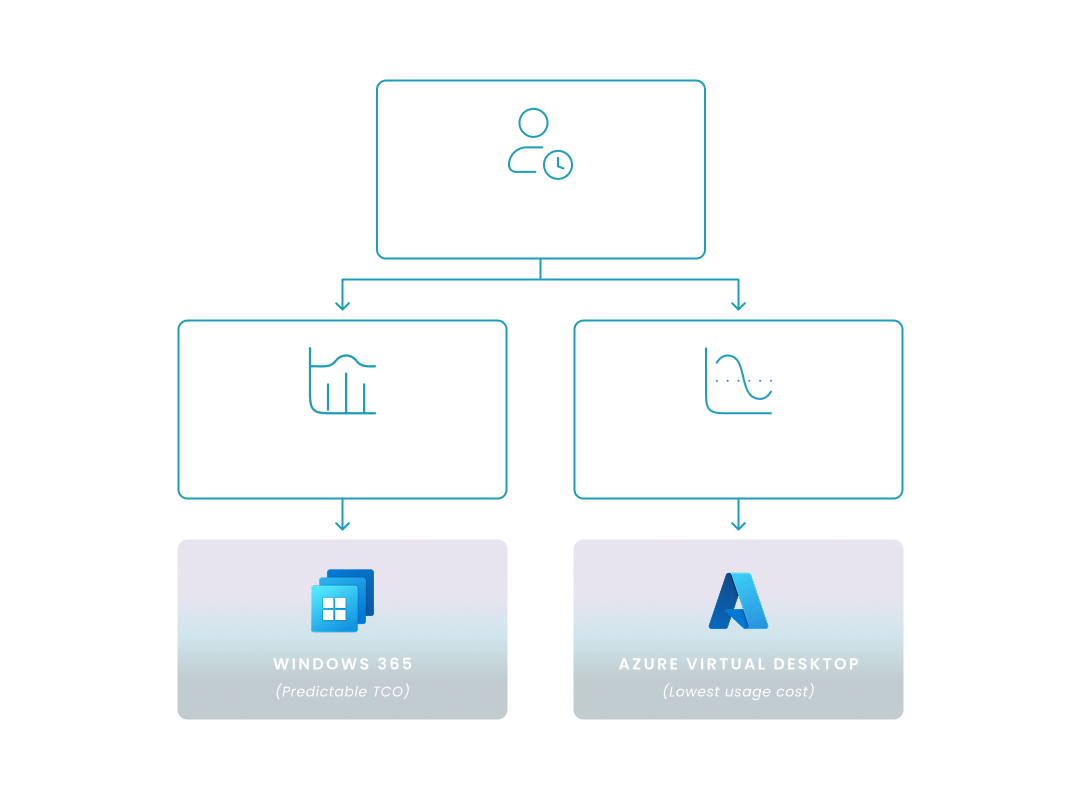NERDIO GUIDE


NERDIO GUIDE
Amol Dalvi | July 28, 2025
This guide is for IT professionals and decision-makers who need to make a financially sound choice between these two powerful Microsoft solutions.
The choice between Azure Virtual Desktop (AVD) and Windows 365 hinges on a trade-off between flexible, usage-based pricing and fixed, predictable costs. AVD is typically more cost-effective for organizations with variable user schedules and high user density by leveraging resource pooling and scaling. In contrast, Windows 365 is often more cost-effective for predictable, full-time usage patterns where its fixed per-user cost and management simplicity reduce the total cost of ownership.
In short, Azure Virtual Desktop (AVD) is a flexible VDI platform that offers deep customization and pay-as-you-go pricing, giving you full control over the underlying Azure infrastructure. In contrast, Windows 365 is a simplified SaaS solution that provides a dedicated "Cloud PC" for a fixed monthly fee, with Microsoft managing the infrastructure for ultimate ease of use. The choice is between AVD's granular control and potential cost savings versus the predictability and simplicity of Windows 365.
As you can see in the table below. one offers you granular control over a flexible environment, while the other provides a simplified, pre-packaged desktop experience.
| Feature | Azure Virtual Desktop (AVD) | Windows 365 Cloud PC |
|---|---|---|
| Pricing Model | Consumption-Based (PAYG) | Fixed Per-User/Per-Month |
| Best For | Variable Usage & High Density | Predictable Usage & Simplicity |
| User Experience | Pooled (Multi-Session) or Personal | Always Personal & Persistent |
| Management | Customer-Managed (Full Control) | Microsoft-Managed |
| Cost Structure | Variable OpEx | Predictable OpEx |
| Customization | High (Custom Images, GPU VMs) | Limited to SKU Selection |
Azure Virtual Desktop is a highly flexible desktop and application virtualization service that runs on your Azure subscription. This flexibility means you can deliver a full desktop experience or choose to stream individual remote apps to a user's local device, making them feel as if they are running locally. Think of it as a toolkit that gives you full control to build and manage a virtual desktop infrastructure (VDI) tailored to your exact needs.
Windows 365 is a Software-as-a-Service (SaaS) solution that delivers a complete, dedicated Cloud PC to each user. It's designed for simplicity and predictability, abstracting away the underlying infrastructure management.
Calculating the Total Cost of Ownership (TCO) requires looking beyond the headline price to understand all the contributing variables for each platform. Windows 365 costs are straightforward and based on licenses, while AVD costs are dynamic and based on resource consumption. While the main cost components are clear, there are plenty of overlooked factors such as inefficient user profile storage, unoptimized network configurations, or neglecting necessary prerequisite licenses that can lead to significant and unexpected cost escalations.
The cost of a Windows 365 Cloud PC is simple to calculate, making it ideal for predictable budgeting.
Calculating AVD's cost is more complex because it’s based entirely on what you use. The main components you pay for are:
The single most effective method for reducing AVD costs is leveraging its inherent scalability through an intelligent autoscaling policy. By automatically turning VMs off during evenings, weekends, or other non-business hours, you stop paying for unused compute resources, and regularly de-provisioning orphaned desktops ensures you aren't paying for storage on resources that are no longer in use. While Azure provides native tools for this, third-party management platforms like Nerdio Manager offer more advanced, automated scaling logic that can more aggressively shut down unused resources to maximize savings.
AVD's pay-as-you-go model makes it the clear financial winner in scenarios where you can capitalize on variable usage and resource sharing. If your organization fits one of the following profiles, AVD will likely offer a lower TCO.
And, while we’re focused on AVD, let’s also ask…
The primary disadvantage of AVD is its management complexity, as it requires significant Azure expertise to configure, deploy, and optimize effectively. This complexity can lead to unpredictable costs if its pay-as-you-go model is not carefully controlled with autoscaling and monitoring, making it challenging to budget for fluctuating user demand. The required management overhead represents a significant operational cost in terms of IT staff time and training.
This step-by-step wizard tool gives you the total cost of ownership for AVD in your organization.
Windows 365 shines where simplicity and predictability deliver more business value than granular control, leading to a lower overall TCO. For many organizations, avoiding complexity is a cost-saving measure in itself.
And, to be fair, let’s also ask…
A primary disadvantage of Windows 365 is its fixed monthly cost, which can be financially inefficient for organizations with part-time or shift-based workers since you pay for the service 24/7 regardless of usage. Additionally, it offers less flexibility and administrative control compared to Azure Virtual Desktop, as you are limited to pre-defined hardware configurations and cannot utilize cost-saving features like multi-session hosts. This makes it less suitable for specialized workloads or scenarios demanding high user density on shared resources.
Join us for a webinar to discover how to take Windows to the cloud. Get insights from industry leaders on navigating the modern workspace and driving secure, cloud-powered operations.
To simplify this complex decision, we've created a decision tree to help you quickly identify the most logical starting point. Follow the questions based on your organization's primary goals, user behavior, and technical requirements. This flowchart provides a high-level recommendation to guide your final analysis and help you focus on the solution that best fits your needs.

And here’s a step-by-step walkthrough of the decision-making process above.
Step 1: Evaluate Your Core Financial and Management Priorities
Step 2: Analyze Your User Work Patterns
Step 3: Assess Your Technical and Application Needs
Step 4: Evaluate Your IT Team's Capacity and Expertise
To make a final decision, you must move from general scenarios to a specific cost model based on your organization's data, and a proper TCO analysis requires gathering key information and using the right tools for estimation.
Use this checklist to gather the data needed for an accurate cost comparison:
This step-by-step wizard tool gives you the total cost of ownership for AVD in your organization.
While AVD and Windows 365 provide the core technology, a third-party management and automation platform can fundamentally change the operational and financial equation for both. These platforms are not a third choice, but rather a layer that enhances the native Microsoft services.
Platforms like Nerdio Manager for Enterprise sit on top of AVD and Windows 365 to dramatically simplify deployment, reduce ongoing management costs, and actively optimize your Azure spending. They are designed to bridge the gap between the powerful but complex capabilities of AVD and the simplicity of Windows 365.
For AVD, the primary value is direct cost reduction. Nerdio's advanced autoscaling technology is the key driver, delivering savings that typically reduce Azure compute and storage costs by 50-75% compared to an unoptimized environment. It achieves this through sophisticated logic that goes beyond native tools by:
Scaling session hosts based on active sessions, CPU, or RAM usage.
Pre-staging hosts just before business hours to ensure availability.
Handling drained session hosts and ensuring user sessions are logged off properly to maximize savings.
This automation directly reduces your Azure bill and also lowers the "soft cost" of IT management by automating complex tasks like image management and host pool creation.
For Windows 365, the value is in operational efficiency and unified management. As enterprises adopt a mix of AVD and Windows 365 for different user types, managing them in separate portals becomes inefficient. Nerdio provides a single pane of glass to:
Deploy, manage, and monitor both AVD hosts and Windows 365 Cloud PCs from one console.
Streamline user provisioning and policy management across both platforms.
Provide a holistic view of your entire virtual desktop estate, simplifying troubleshooting and reporting.
Ultimately, a platform like Nerdio doesn't change the fundamental pricing of Microsoft's services. Instead, it allows you to fully realize the cost-saving potential of AVD and unify the management of your entire virtual desktop environment, reducing the TCO through both aggressive optimization and operational efficiency.
See this demo to learn how you can optimize processes, improve security, increase reliability, and save up to 70% on Microsoft Azure costs.
See how you can optimize processes, improve security, increase reliability, and save up to 70% on Microsoft Azure costs.
Microsoft Entra ID (formerly Azure AD) is a cloud-based identity and access management service that acts as the gatekeeper, handling user sign-in, authentication, and security for various applications. Office 365 (now part of Microsoft 365) is a suite of productivity applications and services, such as Outlook, Word, and Teams, that users access. In short, Entra ID manages who can access resources, while Microsoft 365 is the collection of resources they access.
Migrating from AVD to Windows 365 involves provisioning new Windows 365 Cloud PCs rather than performing a direct, automated conversion. The key steps include preparing a compatible device image, which can often be repurposed from your existing AVD environment, assigning Windows 365 licenses to users, and having them transition their data. After users are successfully established on their new Cloud PCs, you can decommission the AVD session hosts and infrastructure to finalize the move.
A Windows virtual machine (VM) is the foundational building block; it is a self-contained software emulation of a complete computer running its own Windows operating system. A Virtual Desktop Infrastructure (VDI), on the other hand, is the overarching system and technology used to host, manage, and deliver those desktop-powering VMs from a central server to end-users over a network. In short, the VM is the individual desktop instance, while VDI is the framework that delivers and manages it.



Software product executive and Head of Product at Nerdio, with 15+ years leading engineering teams and 9+ years growing a successful software startup to 20+ employees. A 3x startup founder and angel investor, with deep expertise in Microsoft full stack development, cloud, and SaaS. Patent holder, Certified Scrum Master, and agile product leader.